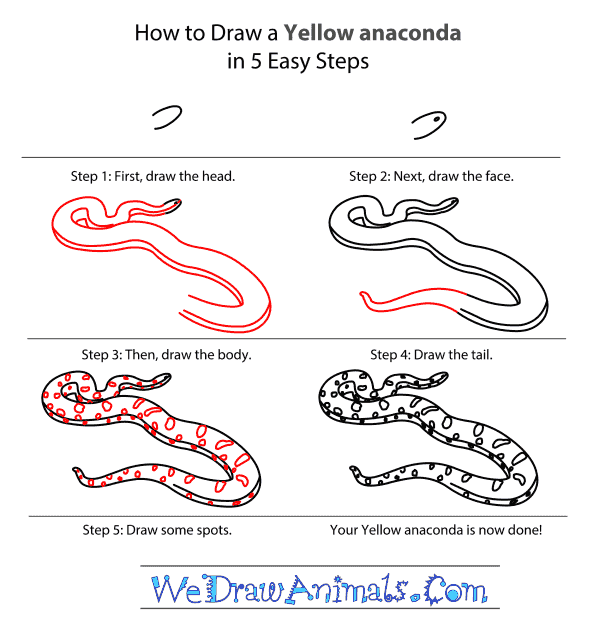In this quick tutorial you'll learn how to draw a Yellow Anaconda in 5 easy steps - great for kids and novice artists.
The images above represent how your finished drawing is going to look and the steps involved.
Below are the individual steps - you can click on each one for a High Resolution printable PDF version.
At the bottom you can read some interesting facts about the Yellow Anaconda.
Make sure you also check out any of the hundreds of drawing tutorials grouped by category.
How to Draw a Yellow Anaconda - Step-by-Step Tutorial
Step 1: The yellow anaconda lives in swamps and rivers. Let's draw the head of the snake first. It looks like the end of a spoon.
Step 2: Add an eye.
Step 3: Next, draw the curving lines that make the body. You can draw it in any way you like! These snakes are big, so make it nice and long.
Step 4: Have the ends of your curved lines taper down into a point for the tail.
Step 5: Now add lots of spots to your snake. Your yellow anaconda is finished! To color it in, the body is yellow and the spots are dark brown or black.
Interesting Facts about the Yellow Anaconda
The yellow anaconda (Eunectes notaeus) are native to South America. They usually live in swamps or slow moving streams, and during droughts, they will seek out holes along river banks that retain water. However, they can also be found in forests.
Did you know?
- While they will feed on smaller prey such as fish, turtles, wading birds, and small mammals, the yellow anaconda are also know to eat much bigger animals such as medium sized deer and wild pigs.
- The yellow anaconda can grow to be over 13 feet long and can weigh over 100 pounds.
- They have yellow-green scales mixed with brown and black stripes and spots that wrap around its body, which serves as camouflage in the water or forest.
- In this species, the females grow longer and weight more than the males.
- While the yellow anaconda can live 15-20 years in the wild, it can live up to 23 years in captivity.
Lesson plan note: Taking into consideration the natural habitat of the yellow anaconda, what kind of animals it often preys on and any other factors, discuss why it has such a longer lifespan while in captivity.






